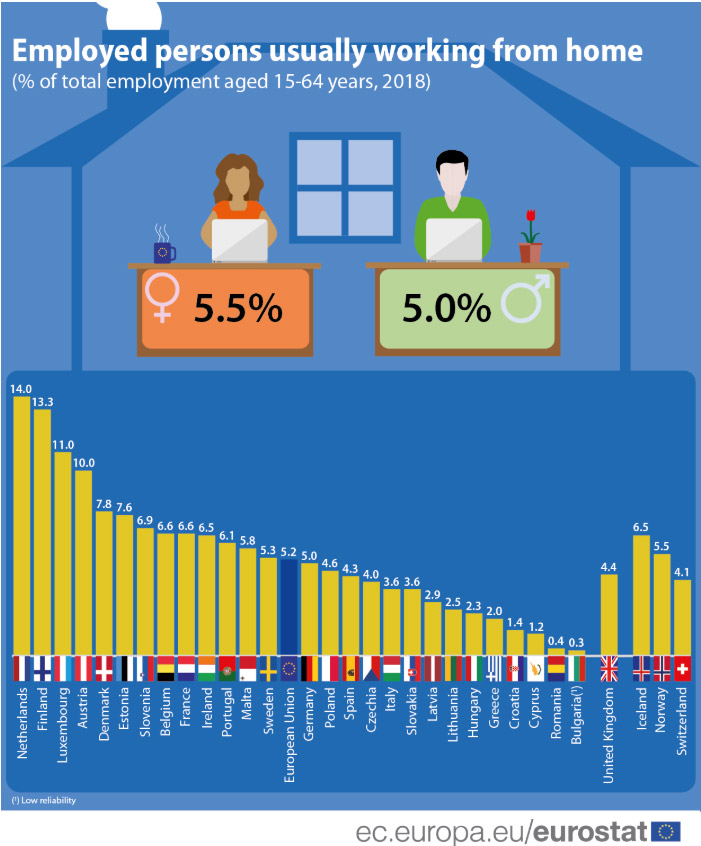Finland heads, together with the Netherlands, the ranking of European Union (EU) countries where it is more common to work from home.
Working from home is still a bit more common among Dutch (14% of them do) than among Finns (13.3%). Those percentages rise above 40% in the specific case of entrepreneurs. The EU average for work from home among all the workforce is 5.2%.
The comparative figures of work from home were published by the EU Statistical Office (Eurostat) on the same day that the Finnish Government released a note in which it warned of low productivity growth in Finland in relation to its main competitors (Sweden, Germany and the United States).
It is noteworthy that in the aforementioned EU countries, where productivity grows at a faster rate, the percentage of employees working from home is less than half that in Finland.

Constant average of 5% during last decade
In 2018, 5.2% of the workers aged 15 to 64 in the European Union (EU) usually worked from home. This share has remained constant at around 5% throughout the last decade. However, in Finland it has been steadily increasing since 2009, when 8.9% of the employees worked from home.
Over the same period, the EU average share of those who sometimes work from home increased from 5.8% in 2008 to 8.3% in 2018.
With 14% of employed people usually working from home in 2018, the Netherlands topped the list of EU Member States, closely followed by Finland (13.3%), Luxembourg (11%) and Austria (10%). In contrast, very few people usually worked from home in Bulgaria (0.3%) and Romania (0.4%).
In the EU, the self-employed usually worked from home (18.5%) more often than employees (3%). This pattern was repeated in each Member State. The highest rates recorded were in Finland where more than 40% of self-employed persons usually worked from home (46.4%), the Netherlands (44.5%) and Austria (43.6%).
More women than men work from home
In 2018, a slightly higher share of women usually worked from home (5.5%) than men (5%). This was the case in most EU Member States, with the largest differences observed in France (8.1% of women, compared to 5.2% of men), Luxembourg (12.5% of women, 9.8% of men) and Malta (7.4% of women, 4.7% of men).
In contrast, in eight EU Member States, the situation was the reverse, with more men usually working from home than women. In the Netherlands (15.5% of men, compared to 12.3% of women), Denmark (8.5% of men, 7.0% of women) and Ireland (7.2% of men, 5.7% of women) this difference was especially large.
Older persons work from home more often
The share of those working from home increases with age.
In the EU, just 1.8% of 15-24 year-olds usually worked from home in 2018, compared to 5% among 25-49 year-olds and 6.4% among 50-64 year-olds. The highest share of 15-24 year-olds who usually worked from home was recorded in Luxembourg (8.7%). The next highest Member State was Estonia (5.2%).
For the other age categories, the Netherlands recorded the highest shares of those usually working from home (14.9% among 25-49 year-olds and 17.3% among 50-64 year-olds). They were followed by Finland (14.0% among 25-49 year-olds and 15.6% among 50-64 year-olds).










